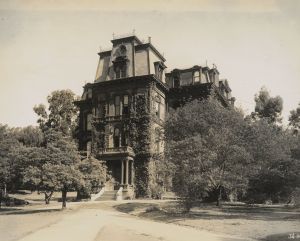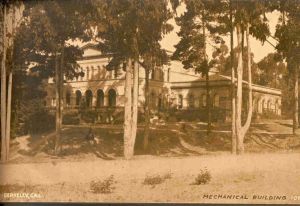From the very inception of the University of California, its founders made it clear that Civil Engineering (CE) was key to the growth and prosperity of the young state of California. The faculty and graduates of the currently named Civil and Environmental Engineering (CEE) Department have proved them right, building a world-leading program at UC Berkeley and a legacy of achievement in California and beyond. This historical summary records some of the people, places, and chronology of the early history of CEE at Berkeley.
The University of California was established in Berkeley in 1868 with a charter that provided for six colleges: Agriculture, Letters, Chemistry, Civil Engineering, Mechanics, and Mining. The Colleges of Civil Engineering and Mining were established in 1872 and the College of Mechanics in 1878. Frank Soule, a US Military Academy graduate, was appointed as Professor of Civil Engineering and was named Dean of the College in 1896, a position he held until 1907.
Early buildings occupied by CE included:
| Civil Engineering and Mining Building, located on the east side of what is now the Campanile Esplanade (about 400 ft. north and 650 ft. east of South Hall); |  |
| Engineering Materials Laboratory (Davis Hall now occupies its site.) When the Engineering Building (now McLaughlin Hall) was completed in 1931, most of the CE faculty moved there. |  |
| Mechanics Building with a hydraulics laboratory (the Bechtel Engineering Center now occupies its site). |  |
(A number of notable CE faculty hired from the inception of the program to 1946 are listed below together with their specialty fields and periods of service. This group remained as faculty at Berkeley for many years, and this faculty tradition of long service continues in CEE to this time.)
In 1931 the Colleges of Civil Engineering and Mechanics merged to become the College of Engineering (COE), with the College of Mining joining in 1942. Professor Charles Derleth followed Professor Soule as Dean of the College of Civil Engineering in 1907 and became Dean of COE in 1931. He remained in this capacity until his retirement in 1942. Professor Donald McLaughlin, Dean of the College of Mining at the time of its merging with COE, followed Derleth as Dean of the newly consolidated COE for 1942-43. He was succeeded by Professor Morrough P. O’Brien (known as the “Father of Coastal Engineering”), who remained as Dean until 1959.
It was during the O’Brien period, particularly following WWII, that the graduate programs in the COE expanded very rapidly, which led to an expansion of the number of faculty in CE and the other departments. The Engineering Council for Professional Development (ECPD) was established in 1932 as the national body charged with accrediting engineering programs, and soon thereafter, in 1936, CE and other programs in the COE received ECPD accreditation.
The first BS degree in CE was awarded in 1873, the first MS degree in Engineering in 1896, and the first PhD in Engineering in 1894. Dean Derleth’s philosophy was that every Civil Engineer should be a Structural Engineer; however, Professor Charles Gilman Hyde (the “Father of Sanitary Engineering in the Western US”), hired in 1905, educated a significant number of CE students in Sanitary Engineering in the period from 1905 to his retirement in 1944 (a total of 229). They called themselves “Professor Hyde’s Boys.”
The Division of Civil Engineering within the COE briefly became the Division of Civil Engineering and Irrigation from 1951-1958, and then was renamed the Department of Civil Engineering from 1958-1995. Finally, in recognition of significant evolution of sub-disciplines within the department and the field, the department was renamed Civil and Environmental Engineering in 1995.
Over its illustrious 139 years, CEE has graduated many students who went on to assume top leadership roles in engineering practice; public works at the federal, state, and local levels; water, power and gas utilities; in entrepreneurial businesses; academia, and professional organizations. A few well-known examples from our earlier years include: Robert Gordon Sproul (CE ’12), President of the University of California; John Bonner (CE ’37) and Barton Shackelford (CE ’41), Presidents of PG&E; William Gianelli (CE ’41), Director, California Department of Water Resources and Assistant Secretary of the US Army; Walter Huber (CE ’05), Founder and Partner, Huber and Knapick, San Francisco; Louis Oppenheim (CE ’38), President, Kaiser Engineers; Edgar Garbarini (CE ’33), President, The Bechtel Group, and Richard Hall (CE ’38), President, Underground Construction. Through the Class of 1950, this group also includes five presidents of the American Society of Civil Engineers.
Recognizing that there are far too many highly successful graduates to list here, the department has partnered with its Advisory Council to establish an Academy of Distinguished Alumni to honor our graduates.
Some Early CEE Faculty
Charles Derleth
Structures, Foundation Engineering
1903-1944 | 41 years of service
Charles Gilman Hyde
Sanitary Engineering
1905-1944 | 39 years of service
Bernard Etcheverry
Irrigation Engineering
1905-1950 | 45 years of service
Francis S. Foote
Surveying and Railroad Engineering
1912-1954 | 42 years of service
Sydney T. Harding
Irrigation Law
1914-1949 | 35 years of service
Clement T. Wiskocil *
Materials, Contract Law
1914-1952 | 38 years of service
William Langlier
Sanitary Engineering,Chemistry
1916-1956 | 40 years of service
Raymond E. Davis
Materials (especially concrete), Structural Engineering
1920-1952 | 32 years of service
Bruce Jameyson
Structural Engineering
1920-1956 | 36 years of service
George E. Troxell
Materials, Structures
1920-1963 | 43 years of service
Harmer E. Davis
Materials, Structures, Soil Mechanics, Transportation
1930-1973 | 43 years of service
Howard D. Eberhart
Structural Engineering (following WWII, engineering-based prosthetic development)
1936-1974 | 38 years of service
Joe W. Johnson
Coastal Engineering
1943-1975 | 32 years of service
Egor P. Popov
Structural Mechanics and Engineering
1946-1976 | 30 years of service
T.Y. Lin
Structural Engineering (especially bridges, pioneered use of prestressed concrete)
1946-1983 | 39 years of service
*deceased prior to retirement
